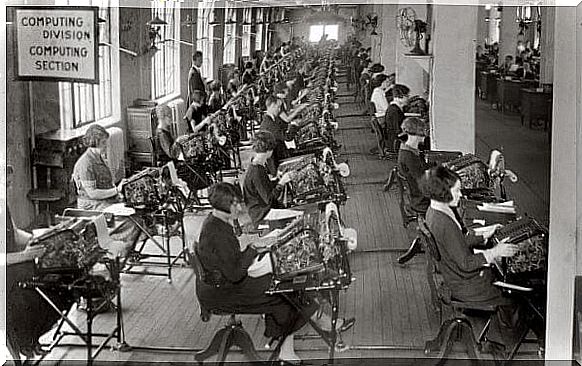The Hawthorne Effect: We Change When Others Look At Us

The hawthorn effect is what we call the change in people when they know they are being seen. People started talking about it after a study done in 1955 by researcher Henry A. Landsberger. Landsberger analyzed experiments performed by Elton Mayo in 1924 and 1932 in a factory called Hawthorne Works.
In his experiments, Mayo wanted to find out if there were any changes in worker productivity due to changes in lighting. In the end, he realized that lighting had no effect on workers’ efficiency, as long as it was above a certain level.
Nevertheless, he noticed an increase in productivity for some of the workers. But it had nothing to do with the light. It was simply that those who thought they were being observed became more productive. Efficiency increased automatically when employees discovered that they were constantly being observed.
Mayo’s first conclusion was that the workers felt special because they were selected for the study. He believed that this was what made them work more efficiently. The other factors such as light, ventilation and infrastructure did not have the slightest effect on them. This is what he called the Hawthorne effect.
Workers’ opinions on the Hawthorne effect
To verify the Hawthorne effect’s existence, the researchers interviewed the workers. They wanted to investigate which factor or factors the workers thought had caused increased productivity. What the workers said really surprised the leaders of the study.

According to the employees, the decisive factor that made them more efficient was a noticeable improvement in the relationship between them. Without realizing it, it seemed as if the researchers had improved the work environment to get the staff to participate in the experiment.
A new branch of psychology was formed because of these results: organizational psychology. They assumed that human relations were an element that played a crucial role in productivity. But the question of the participants who changed just because of the observation remains unanswered.
The Hawthorne effect in today’s world
People have done other studies on this topic since the first effort. But even now, none of them have been absolutely crucial. Nevertheless , people accept the existence of the Hawthorne effect as a positive psychological reaction to being observed during an experiment.
The effect is especially positive when the task we are dealing with is not very complicated. Otherwise, the “observational effect” can be very counterproductive for workers’ efficiency.

It seems that people imagine what researchers expect of them. They do not see the point in acting normally, how they would act in their normal routine. They think they should improve their behavior to the level that researchers want to see. In other words, they set their behavior against what they think it should be.
Of course, this does not only apply to experiments performed in a work environment. We can also extend it to any kind of experiment with humans. Thus, the Hawthorne effect introduces a research bias that every researcher must keep in mind.
Other aspects of the Hawthorne effect
The hawthorn effect is considered to be a particularly problematic factor in medical research. Some patients, when they know they are being observed, will say that they have experienced improvement, even though the tests show otherwise. Objective clinical results show it. The patient says they are doing better, but medical tests say there have been no changes.

The hawthorn effect, or behavior enhancement, does not just happen when a person knows that someone is watching them. It also appears under other circumstances, such as when:
- it is a new situation that changes a person’s routine.
- people feel like part of an artificial situation. For example, when they are in a laboratory.
- the experiment lasts for some time, and the researchers then make a change.
- The person thinks that they are in a situation they could get something out of if they delivered better.
- There are new factors that affect their sense of boredom.
But many doubt how accurate our information about the Hawthorne effect really is. It is a concept that people are still studying. Many questions remain unanswered.
But it is a rather interesting psychological phenomenon that we can use to improve people’s performance in different situations. And as we mentioned, this is especially true when people are doing simple, repetitive tasks.









